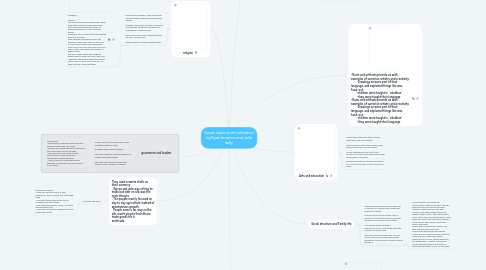
1. religion
1.1. The two main religions of the Yellow River Valley Civilization were Confucianism and Daoism. Buddhism was spread to many civilizations including The Yellow river civilization by missionaries in classical india. Confucianism believes in respect by both the ruler and the ruled. Daoism believes in harmony with the Tao.
1.1.1. Sumerian: Religion: The sumerians practiced polytheism, which means the worship of many gods. Their gods represented different things, for example the god Enil ruled the air and storms Sumerians also believed that god protected each city and state They believed the sumerians were like humans in many ways, they eat, drink, fall in love, and and fight, They are different from humans because they have enormous power, “they could bring rich harvests, or raging floods” Because of their beliefs the sumerians worked hard to please the gods, they built “ziggurats” and temples, where the priests would offer the gods food and drinks, an they also help ceremonies there.
2. goverment and leaders
2.1. Around 4000 B.C the Yellow river valley civilization began in China. It started many Chinese Empires. The rulers of government were chosen on religion and military power. After Zhou Dynasty the leaders were chosen by the “mandate of heaven”.
2.1.1. Government: -Priests held an extremely high status and initially governed the city-states. -As many city-states battled for dominance war chiefs started to rule as kings. -The king's served as the gods chief representatives, they performed ceremonies to please the gods. - Later on the city-state kings formed dynasties, and dynasty is a series or rulers in one family.
3. They used crownie shells as their currency Spices and jade was a thing to trade but later on silk was the main thing to. The people mainly focused on day to day agriculture instead of spontaneous growth. People came a far way on the silk road trying to find silk are trade goods for it. and trade
3.1. Economy and Trade
3.1.1. Economy and Trade: -Sumerians obtained many of their materials for their buildings and art through trade -Sumerians traded with people across southwest asia and beyond. -They exchanged metals, timber, and stone with southwest asia. - Sumerian men were in charge of the trade routes, and politics.
4. -Ruins and artifacts provide us with examples of sumerian artistry and creativity -Drawings on were part of their language, and explained things like war, food, ect. -children were taught in ¨edubbas’ - they were taught their language -Ruins and artifacts provide us with examples of sumerian artistry and creativity -Drawings on were part of their language, and explained things like war, food, ect. -children were taught in ¨edubbas’ - they were taught their language
5. Science and Technolagy
5.1. The “mean people” used stone and bone tools to farm with. They melted bronze to make tools They also used creative writing to stay organized and teach.
5.2. -Sumerians made many scientific advances, they created the wheel, which they used for pottery, and to build a variety of vehicles. -Sumerians also invented the plow -They used bronze to create stronger tools, and weapons. - Archaeological remains show that they even created sewers.
6. Arts and education
6.1. The art they made was pottery such as vases, pots, and grain grinders. Their education was writings about songs, books, and stories on a clay palette. Bronze working was an art but it took practice to do they melted the bronze down and poured it into molds. The people started to domesticate animals for a food source and to use as labor in the fields.
7. Geography and Agriculture
7.1. The Yellow River is the second longest river in China. The Yellow river name comes from loess of yellow sediment it carries when flowing through loess plateau. The two merging rivers create a great food source that feeds the people of the river. The river supplies water to 155 million people.
7.1.1. Geography and Agriculture: In southwest Asia a large band of fertile land forms an oasis in the midst of deserts and mountains, this is called the fertile crescent, it curves between the mediterranean sea and the persian gulf. Rich soil lies between two rivers,the Tigris and the Euphrates. That area is called Mesopotamia, which in Greek means “between the rivers”. In that area the conditions helped bring the world's 1st civilization. Mesopotamia was a flat swampy land, that was well suited for agriculture. Because the land was so good, farming started as early as 5500 BC, in the southern part of Mesopotamia. In southern Mesopotamia there was very little rainfall, so it made farming difficult sometimes.
8. Social structure and Family life
8.1. The Shang king ruled from the capital city of Anyang, His kingdom was divided into different territories. The men and women had equal roles in working, The men hunted and built homes and the women gathered and farmed. The chinese people believed in supernatural forces so that they could talk to gods and receive help. When the families had kids they only had one at a time because they were always farming are moving place to place following the game.
8.1.1. Social Structure, and family life: Families were of high importance, the men were the head of the house and were allowed to have more than one wife. Children were always asked to have the highest respect, and to obey their parents, and in return they were treated fairly as well Sumerians were a social hierarchy having 4 social classes. The Nobles, commoners, clients, and slaves Nobles were ruling families, priests, and they all owned large land areas. Commoners were people who owned smaller pieces of land they were craftsmen, fishermen, ect. Clients were senior administrators /scribes, temple personnel, the dependants of nobility. Slaves were people had been taken in war/ battle, or would sell themselves to pay for their debt.

